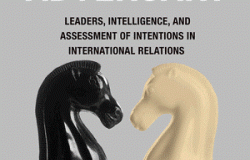Book Review: Knowing the Adversary: Leaders, Intelligence, and Assessment of Intentions in International Relations

Knowing the Adversary: Leaders, Intelligence, and Assessment of Intentions in International Relations by Keren Yarhi-Milo. Princeton / Oxford: Princeton University Press, 2014. 355 pp, $95.00/ £65.00 hardcover 9780691159157, $32.95/ £22.95 paperback 9780691159164
This book addresses a critical question for international relations theory and international security: how do states and their leaders assess the long-term intentions of their adversaries? What types of information and indicators do they use to infer intentions? And how do those inferences translate into policies? Keren Yarhi-Milo draws on empirical historical research to advance a new theoretical framework – the selective attention thesis – that underlines the importance of personal interactions, cognitive and affective factors and organizational dynamics when it comes to threat assessment.
The author, an assistant professor of politics and international affairs at Princeton University, examines three cases: Britain’s assessments of Nazi Germany’s intentions in the 1930s, America’s assessments of the Soviet Union’s intentions during the Carter administration, and the Reagan administration’s assessments of Soviet intentions near the end of the Cold War.
The detailed study of these cases offers surprising results in terms of the validity and limits of some predominant theories of international relations. Leaders and decision makers face information overload and contradictory messages, and their judgements about what information is valid and which indicators are credible have implications that drive not only conclusions, but foreign policies. Yarhi-Milo finds that they are highly determined by their pre-existing beliefs and assumptions and most influenced by personal impressions and face-to-face interactions: what the author calls vivid indicators.
The selective attention thesis posits that the ways in which decision makers form judgements about intentions differ from those of the intelligence community. “Individual perceptual biases and organizational interests and practices are likely to shape what types of indicators are regarded as informative signals of the adversary’s intentions, as well as how these actors interpret such information about intentions” (p. 3). The thesis refers to three key hypotheses: the vividness and the subjective credibility hypotheses affecting decision makers, and the organizational expertise hypothesis concerning state bureaucracies (specifically, the intelligence community).
According to the vividness hypothesis, leaders and decision makers are mainly influenced by vivid information particularly when obtained through personal interactions. This factor is rooted in affective decision-making models and complemented with the subjective credibility thesis: leaders do not necessarily agree with – or even consider important – those indicators that international relations scholars tend to find credible. “What they regard as informative will depend on their own individual theories and expectations about the adversary's behaviour” (p. 4). The organizational expertise hypothesis states that organizational mission and goals contribute to channel attention and affect the selection of information by intelligence agencies. Thus, data on the military capabilities of the adversary tends to receive priority as it is hard data, the expression of hard power, and relatively easy to monitor and quantify.
The author systematically compares the selective attention thesis with three competing explanations of perceived intentions, well rooted in the study and practice of international relations: the capabilities, strategic military doctrine, and behaviour theses. Despite their differences, they share two issues: a reliance on a costly signalling approach (the value of costly and strategic actions to convey information and meaning to others), and the assumption that a state’s assessment of threat and intentions is unitary.
The first chapter explains the theoretical foundations of the selective attention framework and the three competing theses. It includes, in pages 36-37, a summary of predictions for the cases studied according to each framework. Most of the rest of the book comprises the three case studies. For each, an initial chapter outlines the predictions generated by each of the competing explanations. The following chapter uses evidence from archives, interviews, declassified documents and other sources to explore how selected decision makers perceived intentions, how their perceptions evolved and what indicators they used (and omitted) to make assessments. In each case, the last chapter discusses the analyses provided by intelligence agencies during the same period.
The first case study centres on British estimates of Nazi Germany’s intentions in 1934-1939. Germany took several costly international actions that worried British decision makers, including withdrawal from the League of Nations and the Disarmament Conference, militarization of the Rhineland, the Anschluss with Austria, public threats to use force in Sudeten territories and the invasion of Czechoslovakia, coupled with internal militarization. It may seem easy to appreciate hostile intentions in a retrospective analysis, but British decision makers tended to interpret intentions according to their previous beliefs, with those more hawkish giving more importance to these actions while others dismissed them. Vivid information coming from personal interactions had a strong influence: all of the decision makers under study relied heavily on private assurances and personal impressions. Meanwhile, the Foreign Office carefully tracked quantitative trends in the German military arsenal and used them to make inferences. Information about the military build-up and other indicators led British decision makers to ask questions about German intentions, but they “rarely relied on the scope or nature of Germany’s military build-up per se as primary indicator of political intentions” (p. 242).
The Carter Administration and the collapse of détente with the USSR in 1977-1980 are the subject of the second case study. The period started with great optimism about the possibilities of improving the US-USSR relationship, but ended with a broad change of perception and the pursuit of competitive rather than cooperative policies. The change of opinions led Carter to increase the defence budget, withdraw the SALT II Treaty from Senate consideration and develop the Carter doctrine, among other initiatives. Carter, Brzezinski and Vance are the principal actors in this case. There is a useful reference to the Brzezinski document to Carter (dated February 1978) on his thoughts about Soviet intentions (summarized in a table on page 131). Divergent views within the Administration led to an ambivalent foreign policy. The views of those involved changed at different times, according with their prior beliefs. For President Carter, the critical point was the invasion of Afghanistan, seen as a radical change from previous behaviour and a rejection of his personal request of Brezhnev during the Vienna summit to put an end to Soviet interventionism in Africa. The president “experienced a strong emotional reaction of anger, betrayal, and disappointment toward the Soviet leadership” (p. 155). Meanwhile, analysis of the NIEs throughout the period shows that the intelligence community focused on Soviet military capabilities to infer intentions. The fact that decision makers and intelligence relied on different sets of indicators to assess intentions led members of the Carter administration to disregard intelligence analysis as not useful at the political level.
The transition took place in the opposite direction during the Reagan Administrations. President Reagan, who coined the term “evil empire”, shifted during his second term in office. This coincided with the coming to power of the reformist Gorbachev and other factors, and marked a shift in foreign policy that suggests a change in US perceptions about Soviet intentions in the period from 1985 to 1988. According to Yarhi-Milo, this is the easiest test case for the selective attention thesis. Both Reagan and Shultz first focused on past Soviet actions during 1985 and 1986, but dramatically shifted to a focus on then-current activities in 1987. Their beliefs changed most drastically after close, positive and repeated interactions with their Soviet counterparts, and there was a high correlation between beliefs and advocated policies.
The last chapter summarizes the empirical evidence as well as the significance of the findings for theory and policy. The three competing theses (capabilities, military doctrine and behaviour) fail to explain systematic differences between the assessments of decision makers and intelligence organizations in order to infer the intention of an adversary. They also fail to explain differences among decision makers. British and US decision-makers in the cases studied paid the greatest attention to indicators associated with non-capabilities-based behaviour. At the same time, different decision makers within an administration differed on what indicators they considered credible, and often relied on non-costly information provided that it was conveyed in vivid and salient ways: “Leaders as different as Chamberlain and Reagan repeatedly as well as explicitly drew on their personal insights about the sincerity of the adversary’s leaders” (p. 243). In the British case, this made Chamberlain hold his positions while the same type of information led to shifts (in opposite directions) in the Carter and Reagan cases.
The findings of this book have implications for international relations theory. Drawing on outstanding empirical work, it shows that leaders engage in diplomacy and draw inferences about the behaviour of their adversaries in ways that depart from major claims found in international relations scholarship. The author assumes that conclusions should not be considered definitive (p. 250) and suggests avenues for further research. In terms of policy implications, this points to the importance of personal diplomacy and reassuring actions as an effective tool in influencing others’ perceptions. As Yarhi-Milo suggests, the study might help to evaluate US leadership assessments of China’s long-term political intentions during the last decade. If the results are replicable, it might well be the case that US leaders have not been relying on intelligence estimates of military capabilities in assessing China’s political intentions, but on other less systematized information.
The book tests theories of rational choice, organization theory, and psychology. It constitutes an empirical and detailed piece of historical research based on primary sources and compelling evidence, which profoundly enriches the debate about a central question in international security. It contains elements that help the reader navigate through complex theoretical arguments, such as tables, a summary of hypotheses, and an extensive and rich notes section and associated bibliography. The coverage of primary sources, historical research and the systematic testing of theories with historical cases make it compelling for scholars on conflict and international relations, but also for intelligence analysts and diplomats.
Mabel González Bustelo is a journalist, researcher and international consultant, specializing in peace and security. A contributing analyst to Wikistrat, she is also the author of "Narcotráfico y crimen organizado: ¿Hay alternativas?" (Icaria, Barcelona, 2014).


